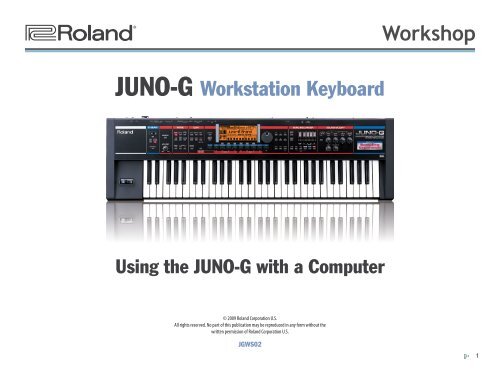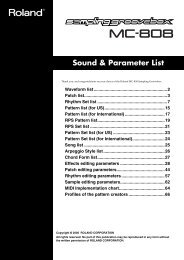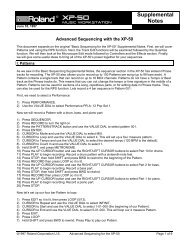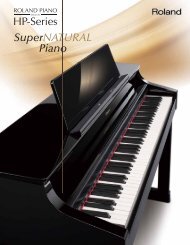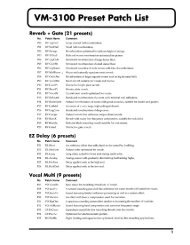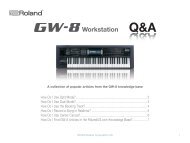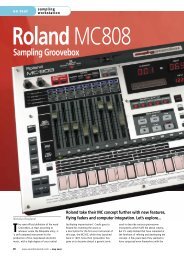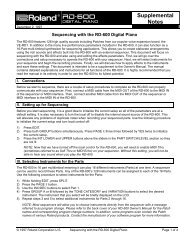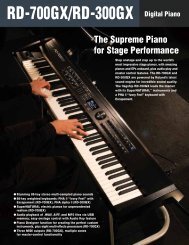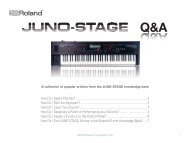JGWS02—Using the JUNO-G with a Computer - Roland ...
JGWS02—Using the JUNO-G with a Computer - Roland ...
JGWS02—Using the JUNO-G with a Computer - Roland ...
Create successful ePaper yourself
Turn your PDF publications into a flip-book with our unique Google optimized e-Paper software.
About <strong>the</strong> Workshop Booklets<strong>Roland</strong>’s <strong>JUNO</strong> syn<strong>the</strong>sizers have been making history since <strong>the</strong> 1980s.They’ve always been affordable, easy to use, and sounded great onstageand in <strong>the</strong> studio. The <strong>JUNO</strong>-G carries on <strong>the</strong> family tradition in <strong>the</strong> mostmodern way, <strong>with</strong> 128-note polyphony and killer sounds derived from<strong>Roland</strong>’s acclaimed Fantom-X synths—even more sounds are available whenyou install an optional SRX-series sound expansion board. The <strong>JUNO</strong>-G hasa user-friendly 16-track sequencer, 4-track audio recorder, and a full-onsampler that give you <strong>the</strong> tools you need to bring your songs to life. AUSB jack allows you to easily exchange data <strong>with</strong>—or edit <strong>JUNO</strong>-G soundsfrom—a personal computer. And it’s all tied toge<strong>the</strong>r <strong>with</strong> a look and feelthat’s both familiar and intuitive.This <strong>JUNO</strong>-G Workshop Series booklet is intended as a companion to <strong>the</strong><strong>JUNO</strong>-G Owner’s Manual. It requires <strong>JUNO</strong>-G Operating System v2.0 or higher.You can download <strong>the</strong> latest <strong>JUNO</strong>-G O.S. for free from www.<strong>Roland</strong>US.com.About This BookletHot LinksEach Workshop booklet is meant to be read in order from beginningto end. However, if we mention an upcoming section—and you seethis arrow—you can click <strong>the</strong> arrow to jump <strong>the</strong>re immediately.Things You Can Do <strong>with</strong> Your MIDI ConnectionIn this booklet, we’re going to assume you know how to operate yourcomputer. If you don’t, consult its documentation before proceeding.Edit and Create <strong>JUNO</strong>-G SoundsThe <strong>JUNO</strong>-G ships <strong>with</strong> Editor and Librarian software for Mac and PCthat makes <strong>the</strong> <strong>JUNO</strong>-G even more powerful. The Editor software allowsyou to edit factory sounds, or create your own, on your computer. TheLibrarian software helps you organize and store your <strong>JUNO</strong>-G sounds andperformances on your computer’s hard drive.The <strong>JUNO</strong>-G can exchange MIDI data <strong>with</strong> a Mac or PC via USB, letting youuse <strong>the</strong> <strong>JUNO</strong>-G as MIDI controller for a DAW and/or as a multitimbral soundmodule. It also allows you to create <strong>JUNO</strong>-G sounds on your computer. Thisbooklet explains how to get connected.Current settings......go to <strong>the</strong> <strong>JUNO</strong>-G.Understanding <strong>the</strong> Symbols in This BookletUSBUSB...are sent to <strong>the</strong> software.Throughout this booklet, you’ll come across information that deservesspecial attention—that’s why it’s labeled <strong>with</strong> one of <strong>the</strong> following symbols.Your edited settings...A note is something that adds information about <strong>the</strong> topic at hand.A tip offers suggestions for using <strong>the</strong> feature being discussed.Warnings contain important information that can help you avoidpossible damage to your equipment, your data, or yourself.The Editor and Librarian come <strong>with</strong> <strong>the</strong>ir own documentation, so we’rejust going to discuss <strong>the</strong>ir installation in this booklet.2
Use <strong>the</strong> <strong>JUNO</strong>-G <strong>with</strong> a DAWMIDI notes......where <strong>the</strong>y play notes.USBYou can use a GM2 System On message contained in an SMF file toselect <strong>the</strong> <strong>JUNO</strong>-G’s General MIDI 2 sounds, or you can press <strong>the</strong><strong>JUNO</strong>-G’s PERFORM button and select PRST 064 GM2 Template.Setting Up Your <strong>Computer</strong> for <strong>the</strong> <strong>JUNO</strong>-GUSB...are captured in <strong>the</strong> DAW.Notes go to <strong>JUNO</strong>-STAGE...Installing <strong>the</strong> <strong>JUNO</strong>-G Software on Your <strong>Computer</strong>The <strong>JUNO</strong>-G works <strong>with</strong> <strong>the</strong> following operating systems:• Windows XP • Windows Vista 32-bit Edition • Mac OS XIn this booklet we’ll describe <strong>the</strong> Windows XP, Vista, and Mac OS X installationof <strong>the</strong> <strong>JUNO</strong>-G’s USB MIDI driver, Editor and Librarian software.The <strong>JUNO</strong>-G makes an excellent MIDI controller for a DAW. By pluggingearbuds or headphones into your computer, you can use a DAW’s softsynths; plugging <strong>the</strong>m into <strong>the</strong> <strong>JUNO</strong>-G lets you use <strong>JUNO</strong>-G sounds. In amore complex setup, you can listen to both through an audio interface.Play General MIDI2 SMFs from a <strong>Computer</strong>If you have aprogram on yourcomputer thatplays General MIDIor General MIDI2SMFs (“StandardMIDI Files”), youcan play <strong>the</strong>musing <strong>the</strong><strong>JUNO</strong>-G’s built-inGM2 sounds.USBThe <strong>JUNO</strong>-G must be ready to boot up into USB MIDI mode in order toinstall its driver. See “Selecting <strong>the</strong> USB Operating Mode” on Page 167of <strong>the</strong> Owner’s Manual to learn how to set up <strong>the</strong> <strong>JUNO</strong>-G to do so.When you connect <strong>the</strong> <strong>JUNO</strong>-G to your computer via USB, you’lltypically get <strong>the</strong> best results using USB jacks on <strong>the</strong> back of a desktopcomputer or on <strong>the</strong> side of a laptop. We recommend not using a hub.The <strong>JUNO</strong>-G’s software is on <strong>the</strong> CD-ROM that came <strong>with</strong> it. If you’re using• Windows XP— you’ll find <strong>the</strong> driver in <strong>the</strong> Win2kXP folder at <strong>the</strong>CD-ROM’s root level. The Editor installer (which includes <strong>the</strong> Librariansoftware) can be found in <strong>the</strong> root level’s Installer folder.• Vista— you’ll find <strong>the</strong> driver Setup executable file and <strong>the</strong> Editor installer(which includes <strong>the</strong> Librarian software) in <strong>the</strong> Install folder at <strong>the</strong>CD-ROM’s root level.• Mac OS X— you’ll find <strong>the</strong> driver installer, and <strong>the</strong> Editor/Librarianinstaller in <strong>the</strong>ir folders at <strong>the</strong> root level of <strong>the</strong> CD-ROM.You can find <strong>the</strong> latest <strong>JUNO</strong>-G software on <strong>the</strong> Downloads tab at http://www.rolandus.com/products/productdetails.php?ProductId=756.3
Windows XPInstalling <strong>the</strong> <strong>JUNO</strong>-G USB MIDI Driver1 Power up your PC <strong>with</strong> all USB cables disconnected except for yourkeyboard and mouse. If any applications are running, quit <strong>the</strong>m.2 Double-click <strong>the</strong> Setup file in <strong>the</strong> XP Drivers folder, or <strong>the</strong> installeryou’ve downloaded and unzipped, to start <strong>the</strong> installer.4If you see <strong>the</strong> Software Installation window instead of<strong>the</strong> one shown above, click Continue Anyway. If you can’tcontinue, see “About Driver Signing Options” later in thisbooklet. (You can click this button to jump <strong>the</strong>re now.)Click Next—<strong>the</strong> driver is installed and instructions appear telling youwhat to do next.3If XP asks if you want to run this file, click Run. If an “Install Programas O<strong>the</strong>r User” dialog appears, quit <strong>the</strong> installer, and <strong>the</strong>n log in as <strong>the</strong>system administrator before re-launching <strong>the</strong> Setup application.Click Next to display <strong>the</strong> installation start window:56We’ll take you through <strong>the</strong>se instructions in this booklet, so you canclose this window, or drag it over to <strong>the</strong> side of <strong>the</strong> screen if you wantto keep it open.With <strong>the</strong> <strong>JUNO</strong>-G’s power turned off, plug one end of <strong>the</strong> includedUSB cable into its USB jack, and <strong>the</strong> o<strong>the</strong>r end into <strong>the</strong> USB jack youwant to use on your computer.Turn on <strong>the</strong> <strong>JUNO</strong>-G—after a few moments, <strong>the</strong> PC’s Found NewHardware Wizard window appears, as shown in <strong>the</strong> followingscreenshot.If, instead of seeing <strong>the</strong> Found New Hardware window, you’re asked ifyou want to connect to Windows Update, select No, not this time, and<strong>the</strong>n click Next to display <strong>the</strong> Found New Hardware window.4
About Driver Signing OptionsThe Driver Signing window lets you select whe<strong>the</strong>r Windows should block<strong>the</strong> installation of an unknown driver, warn you about it, or just install it.12In <strong>the</strong> Start menu, select Control Panel.If you’re in• Category View— click Performance and Maintenance, and <strong>the</strong>nclick System.• Classic View— double-click System.7Click <strong>the</strong> button to <strong>the</strong> left of “Install <strong>the</strong> software automatically(Recommended),” and <strong>the</strong>n click Next to install <strong>the</strong> driver.When <strong>the</strong> driver’s installed, <strong>the</strong> wizard announces <strong>the</strong> completion of<strong>the</strong> installation process.If <strong>the</strong> “Software installation” window appears after you click Next,click Continue Anyway. If you can’t continue, see “About Driver SigningOptions” to <strong>the</strong> right of this page.8If <strong>the</strong> “System Settings Change” window appears, click Yes to restartWindows.Click Finish.Windows displays “Your new hardware is ready to use.”9 If <strong>the</strong> Driver Setup window’s still open, click its Close button.10 Restart your computer.3Click <strong>the</strong> Hardware tab, and <strong>the</strong>n click Driver Signing.4 Set “What action do you want Windows to take?” to Ignore or Warn.5Click OK to close <strong>the</strong> Driver Signing window.Should you ever need to remove <strong>the</strong> <strong>JUNO</strong>-G driver from your system,its installer folder contains an uninstaller. You can hold onto this file,or re-download <strong>the</strong> driver folder later should you need it.Later in this booklet, we’ll provide some fur<strong>the</strong>r informationon using <strong>the</strong> <strong>JUNO</strong>-G <strong>with</strong> a DAW. Click <strong>the</strong> button here tojump to this section now if you like.67Click OK to close <strong>the</strong> System Properties window.Return to <strong>the</strong> driver installation instructions earlier in this booklet.5
Installing <strong>the</strong> Editor/Librarian SoftwareYou can install both <strong>the</strong> <strong>JUNO</strong>-G Editor and Librarian software in a singleoperation. Here’s how to do this.6Highlight <strong>the</strong> Custom installation, and <strong>the</strong>n click Next.12Double-click <strong>the</strong> <strong>JUNO</strong>-G Editor Setup executable file.The installer opens. (If XP asks if you want to run thisfile, click Run.)Choose your setup language and click Next.7Checkmark all of <strong>the</strong> files in <strong>the</strong> Select Features window—if <strong>the</strong>y’renot already checked—and <strong>the</strong>n click Next.If you want to install only one of <strong>the</strong> <strong>JUNO</strong>-G programs, make sure itsfiles are all that’s checked in this window.345Enter your name and decide whe<strong>the</strong>r to install <strong>the</strong> driver only for <strong>the</strong>current user of your computer, or for all users, and <strong>the</strong>n click Next.Read <strong>the</strong> License Agreement, and if you’d like to proceed <strong>with</strong> <strong>the</strong>installation, click Yes.In <strong>the</strong> Choose Destination Location window, you can select a locationon your hard drive for <strong>the</strong> <strong>JUNO</strong>-G software—if you don’t have aspecific reason to change it, leave <strong>the</strong> default location as it is—and<strong>the</strong>n click Next to display <strong>the</strong> Setup Type window.89VistaThe installer displays your installation selections and tells you it’s nowready to install <strong>the</strong> <strong>JUNO</strong>-G software. Click Next to proceed—<strong>the</strong> filesare installed.Click Finish to exit <strong>the</strong> installer.Installing <strong>the</strong> <strong>JUNO</strong>-G USB MIDI Driver1 Power up your PC <strong>with</strong> all USB cables disconnected except for yourkeyboard and mouse. If any applications are running, quit <strong>the</strong>m.2 Double-click <strong>the</strong> Setup file in <strong>the</strong> Vista Drivers folder, or <strong>the</strong> installeryou’ve downloaded and unzipped, to start <strong>the</strong> installer.If Vista tells you a program needs your permission to continue, clickContinue.6
3The Driver Setup window appears:4Click Next to display <strong>the</strong> Driver Setup instructions window:We’ll take you through <strong>the</strong>se instructions in this booklet, so you canclose this window.7 With <strong>the</strong> <strong>JUNO</strong>-G’s power turned off, plug one end of <strong>the</strong> includedUSB cable into its USB jack, and <strong>the</strong> o<strong>the</strong>r end into <strong>the</strong> USB jack youwant to use on your computer.8 Turn on <strong>the</strong> <strong>JUNO</strong>-G—after a few moments, “Installing device driversoftware” appears in <strong>the</strong> lower right corner of <strong>the</strong> screen.9 When <strong>the</strong> PC’s finished installing <strong>the</strong> driver, “<strong>JUNO</strong> Series Devicedriver software installed successfully” appears onscreen.10 Restart your computer.5Click Next.Later in this booklet, we’ll provide some fur<strong>the</strong>r informationon using <strong>the</strong> <strong>JUNO</strong>-G <strong>with</strong> a DAW. Click <strong>the</strong> button here tojump to this section now if you like.Installing <strong>the</strong> Editor and Librarian SoftwareHere’s how to install <strong>the</strong> <strong>JUNO</strong>-G Editor and Librarian software.6If Windows Security asks if you’d like to install this device software—as shown above—click Install.1Double-click <strong>the</strong> <strong>JUNO</strong>-G Editor Setup executable file.The installer opens.If you plan to instal o<strong>the</strong>r <strong>Roland</strong> drivers in <strong>the</strong> future, you can checkAlways trust software from “<strong>Roland</strong> Coporation” to save time later.If Vista tells you a program needs your permission to continue or thatit doesn’t recognize <strong>the</strong> program, click Continue.The driver’s installed, and a window opens <strong>with</strong> instructions.2Choose English as your setup language and click OK.7
PianoMIDIChannel 1Part 1—PRA:001 <strong>JUNO</strong>-G Grand2Press F5 (PARTVIEW).BassMIDIChannel 2Part 2—USER:024 Comp’d BassDrumsDAW tracksMIDIChannel 10Part 10—PRST:01 StandardKit1<strong>JUNO</strong>-G performance partsThe performance’s parts are also set to respond to various MIDIProgram Change, Bank Select, and Control Change messages. Allof <strong>the</strong> parts are also set to default levels you can change <strong>with</strong> MIDImessages from <strong>the</strong> DAW.If your screen doesn’t look like this, press F1 (PART).3 Select <strong>the</strong> part for which you want to select a sound byhighlighting one of its parameters.4 Press <strong>the</strong> ENTER button to display <strong>the</strong> CATEGORY screen fromwhich you can select <strong>the</strong> sound you want <strong>the</strong> part to play.To learn about MIDI Program Change, Bank Select, and Control Changemessages, see our An Introduction to MIDI InFocus booklet. To learnhow to work <strong>with</strong> <strong>the</strong>m in your DAW, see your DAW’s documentation.7You’re now set up.As you sequence tracks, <strong>the</strong>re’s nothing you need to do on <strong>the</strong><strong>JUNO</strong>-G o<strong>the</strong>r than play. Everything else takes place in <strong>the</strong> DAW.About Selecting <strong>JUNO</strong>-G Sounds for Use <strong>with</strong> a DAWNo matter how you decide to select <strong>JUNO</strong>-G sounds for use <strong>with</strong> a DAW,we recommend starting <strong>with</strong> PRST 002 Seq: Template.When you’re playing <strong>JUNO</strong>-G sounds from a DAW, <strong>the</strong>re are three ways toselect <strong>the</strong> sounds in <strong>the</strong> <strong>JUNO</strong>-G performance you use.• You can create a performance <strong>with</strong> <strong>the</strong> desired sounds on <strong>the</strong><strong>JUNO</strong>-G—Here’s how:1Press <strong>the</strong> PERFORM button to display <strong>the</strong> PERF PLAY screen.To learn about navigating <strong>the</strong> CATEGORY screen, see Page 5 of <strong>the</strong><strong>JUNO</strong>-Geography Workshop booklet.5 Select <strong>the</strong> desired sound for <strong>the</strong> part and press ENTER to lock inyour choice.6 Repeat Steps 3-5 to select <strong>the</strong> performance’s o<strong>the</strong>r sounds.• You can build <strong>the</strong> performance you want using <strong>the</strong> <strong>JUNO</strong>-G Editor— onyour computer, and <strong>the</strong>n send it to <strong>the</strong> <strong>JUNO</strong>-G’s memory.To preserve performances you create using ei<strong>the</strong>r method, write <strong>the</strong>minto <strong>the</strong> <strong>JUNO</strong>-G’s memory. See Page 63 in <strong>the</strong> Owner’s Manual.The DAW tracks can select each part’s sound—• by sending MIDI BankSelect and Program Change messages to <strong>the</strong> <strong>JUNO</strong>-G on <strong>the</strong> part’s MIDIchannel.12
Configuring Your DAW for Use <strong>with</strong> <strong>the</strong> <strong>JUNO</strong>-GOnce you’ve installed <strong>the</strong> <strong>JUNO</strong>-G driver and made your USB connection,your software DAW can• receive MIDI data from <strong>the</strong> <strong>JUNO</strong>-G— This allows you to play <strong>the</strong> DAW’ssoft synths, and to sequence your playing onto DAW tracks.• use <strong>the</strong> <strong>JUNO</strong>-G as a destination for outgoing MIDI data— This allows <strong>the</strong>DAW to play <strong>the</strong> <strong>JUNO</strong>-G’s sounds from its tracks.While each DAW has its own way of doing things, <strong>the</strong> following generalprinciples always apply. (You can consult your software’s documentation fordetails.)Receiving <strong>JUNO</strong>-G MIDI Data in a DAWSending Data from DAW Tracks to <strong>the</strong> <strong>JUNO</strong>-GAll DAWs provide a method for directing sequenced MIDI data fromindividual MIDI tracks to <strong>the</strong> desired external devices—for example, <strong>the</strong>parts of a <strong>JUNO</strong>-G performance. Consult your DAW’s documentation to learnhow to direct <strong>the</strong> data on each of your DAW’s MIDI tracks to <strong>the</strong> desired<strong>JUNO</strong>-G parts.The EndWe hope you’ve found this workshop helpful. Keep an eye out for new<strong>JUNO</strong>-G updates and support documents you can download for free atwww.<strong>Roland</strong>US.com.To get your DAW to receive MIDI data from <strong>the</strong> <strong>JUNO</strong>-G, select <strong>the</strong><strong>JUNO</strong>-G as a MIDI input <strong>with</strong>in <strong>the</strong> DAW, or set <strong>the</strong> DAW to receive all MIDIdata coming into <strong>the</strong> computer. If your DAW can accept MIDI data on all MIDIchannels—often referred to as “omni” mode—enable this option.As we mentioned earlier, <strong>the</strong>re’s seldom a need to match <strong>the</strong> DAW’s incomingMIDI channel to <strong>the</strong> <strong>JUNO</strong>-G’s transmit channel. However, if you need to dothis, here’s how to figure out and/or set <strong>the</strong> <strong>JUNO</strong>-G’s MIDI transmit—shownas “Tx” onscreen—channel.If• you’ve selected a performance on <strong>the</strong> <strong>JUNO</strong>-G so you can sequence usingmultiple <strong>JUNO</strong>-G sounds—each of <strong>the</strong> performance’s parts transmitson its same-numbered MIDI channel. From <strong>the</strong> PERFORM PLAY screen,press F5 (PARTVIEW), shown on Page 12, and <strong>the</strong>n use <strong>the</strong> 6 and 5buttons to move from part to part. The <strong>JUNO</strong>-G will transmit MIDI dataon <strong>the</strong> currently selected part’s channel.• you haven’t selected a performance on <strong>the</strong> <strong>JUNO</strong>-G— you can set <strong>the</strong>system-wide Kbd Patch Rx/Tx Channel parameter to <strong>the</strong> desiredchannel. To get to <strong>the</strong> parameter, follow <strong>the</strong> instructions on Page 11 ofthis booklet to navigate to <strong>the</strong> MIDI General screen.13


